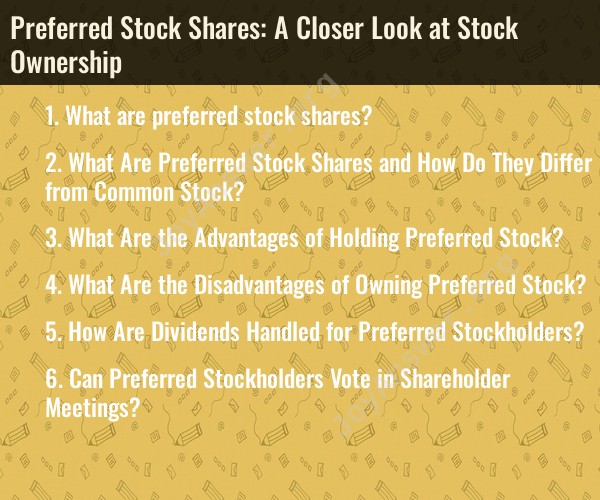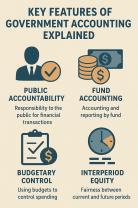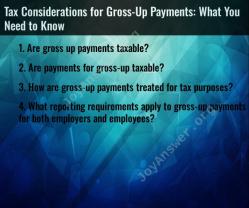What are preferred stock shares?
Preferred stock shares are a class of ownership in a corporation that has characteristics of both common stock and bonds. They represent an ownership stake in the company, but they come with certain preferences and rights that distinguish them from common stock. Here are some key characteristics of preferred stock shares:
Priority in Dividends: Preferred stockholders have a priority over common stockholders when it comes to receiving dividends. The company must first pay dividends to preferred shareholders before distributing any dividends to common shareholders. However, the exact dividend rate can vary and is typically fixed.
Fixed Dividend Rate: Preferred stock often carries a fixed dividend rate, which means that the dividend amount is predetermined and does not fluctuate with the company's profits. Common shareholders, on the other hand, receive dividends based on the company's performance.
Limited Voting Rights: Preferred stockholders usually have limited or no voting rights in the company. They may not have the same influence over corporate decisions as common shareholders.
Priority in Asset Distribution: In the event of the company's liquidation or bankruptcy, preferred stockholders have a higher claim on the company's assets compared to common stockholders. They are entitled to receive their investment back before common shareholders receive any remaining assets.
Cumulative or Non-Cumulative: Preferred stock can be cumulative or non-cumulative. Cumulative preferred stock means that if the company does not pay the scheduled dividends in a particular period, those unpaid dividends accumulate and must be paid to preferred shareholders in the future. Non-cumulative preferred stock does not allow for the accumulation of unpaid dividends.
Callable or Non-Callable: Some preferred stocks are callable, meaning the company has the option to buy back the shares from shareholders at a predetermined price. Callable preferred stock can be redeemed by the issuer after a certain date. This feature can affect the potential returns for shareholders.
Convertible or Non-Convertible: Some preferred stock shares are convertible, which means they can be exchanged for a predetermined number of common shares, allowing the shareholder to benefit from any potential increase in the common stock's value.
Preferred stock is often considered a hybrid security because it combines elements of both equity and debt. It provides a stable income stream through fixed dividends while offering some protection in terms of asset distribution. However, it generally does not have the same potential for capital appreciation as common stock.
Investors who prefer a more stable income and are willing to forgo some voting rights and potential for capital gains may choose to invest in preferred stock shares.
What Are Preferred Stock Shares and How Do They Differ from Common Stock?
Preferred stock shares are a type of equity security that represents ownership in a company. Preferred shareholders have certain rights and preferences over common shareholders, including:
- Priority in dividends: Preferred shareholders are entitled to receive dividends before common shareholders.
- Priority in liquidation: In the event of liquidation, preferred shareholders have a higher claim on the company's assets than common shareholders.
- Callable feature: Some preferred stock shares are callable, which means that the company can redeem the shares at a predetermined price.
What Are the Advantages of Holding Preferred Stock?
Some of the advantages of holding preferred stock include:
- Higher dividend yields: Preferred stock typically has higher dividend yields than common stock. This is because preferred shareholders have a higher claim on the company's earnings.
- Greater stability: Preferred stock is generally considered to be a more stable investment than common stock. This is because preferred shareholders have priority in dividends and liquidation.
- Potential for capital appreciation: While preferred stock is not as volatile as common stock, it still has the potential to appreciate in value.
What Are the Disadvantages of Owning Preferred Stock?
Some of the disadvantages of owning preferred stock include:
- Lower growth potential: Preferred stock typically has lower growth potential than common stock. This is because preferred shareholders do not have the same ownership rights and privileges as common shareholders.
- Limited voting rights: Preferred shareholders typically do not have the right to vote in shareholder meetings. This means that they have less control over the company's management.
- Callable feature: If a preferred stock share is callable, the company has the right to redeem the share at a predetermined price. This means that preferred shareholders could be forced to sell their shares even if they do not want to.
How Are Dividends Handled for Preferred Stockholders?
Preferred stock dividends are typically paid on a quarterly basis. However, some preferred stock shares may pay dividends on a monthly, semiannual, or annual basis.
Can Preferred Stockholders Vote in Shareholder Meetings?
Most preferred stockholders do not have the right to vote in shareholder meetings. However, some preferred stock shares may have limited voting rights, such as the right to vote on certain types of mergers and acquisitions.
Overall, preferred stock can be a good investment option for investors who are looking for a steady stream of income and lower volatility. However, it is important to understand the risks and disadvantages of preferred stock before investing.













